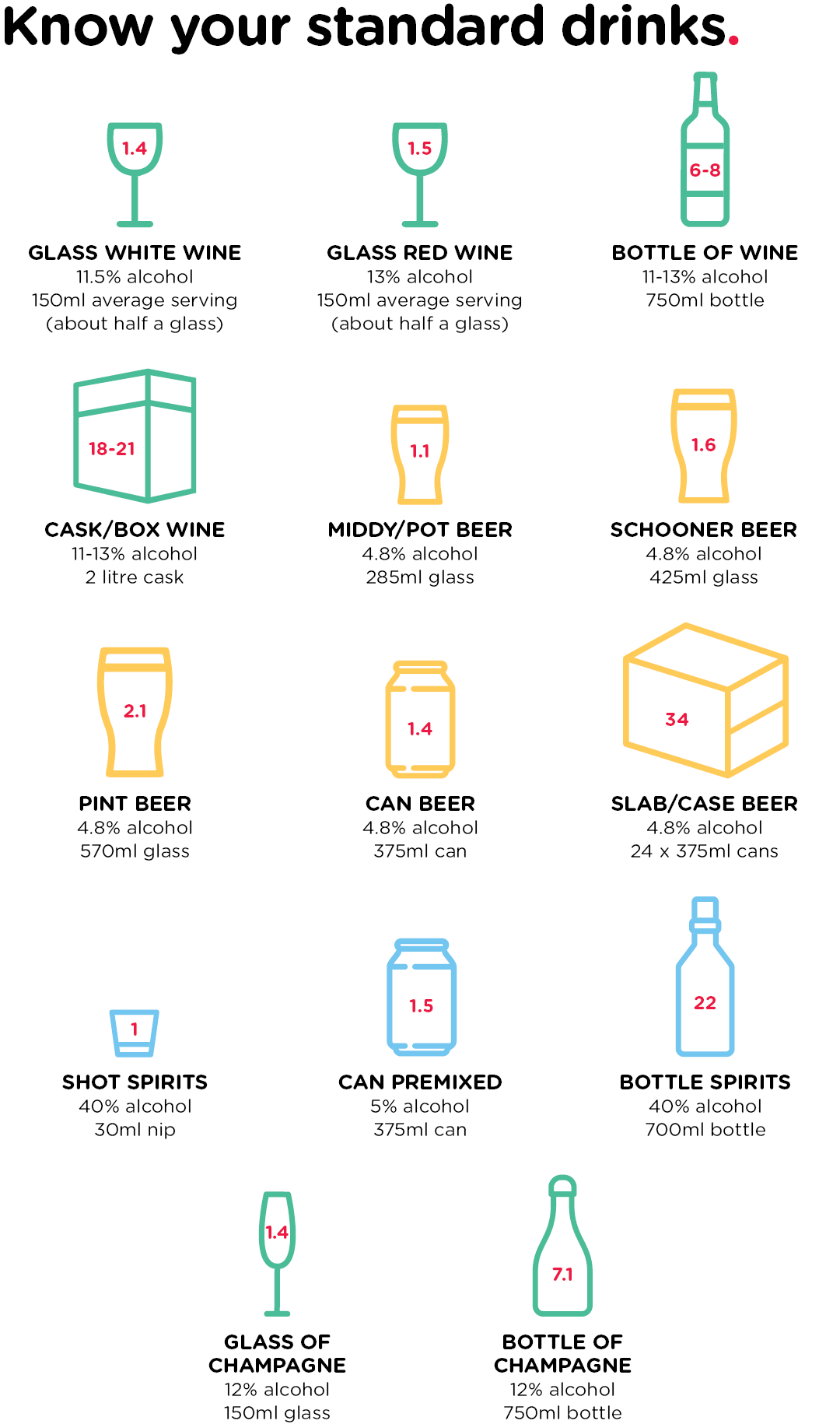Australian alcohol guidelines
While there’s no safe level of drinking, the guidelines provide a framework for how to stay healthy and protect yourself and your family from alcohol harm.
The guidelines recommend that:
- to reduce the risk of harm from alcohol-related disease or injury for healthy men and women, drink no more than 10 standard drinks per week and no more than 4 standard drinks on any one day
- anyone under 18 should not drink alcohol to reduce the risk of injury and harm to the developing brain
- women who are pregnant or breastfeeding should not drink alcohol to prevent harm to their baby.
Standard drinks
It can be difficult to keep track of how much alcohol you’re consuming because different types of drinks contain different amounts of alcohol and come in different sizes.
A standard drink might be less than you think. For example, a bottle of beer or a glass of wine is often more than a 'standard drink'. An Australian standard drink contains 10g of alcohol (12.5ml of pure alcohol). One standard drink is 285ml of full-strength beer, a 100ml glass of wine, or 30ml of spirits.
Tracking how many standard drinks you’re consuming can help you follow the guidelines so you can stay as healthy as possible.

- Spirits 40% alcohol, 30ml nip
- Wine 13% alcohol, 100ml average serving
- Sparkling wine 13% alcohol, 100ml
- Full strength beer 4.9% alcohol, 285ml glass
- Light beer 2.7% alcohol, 425ml glass
- Cider 4.9% alcohol, 285ml glass
Check out the Drinking Calculator to find out how your drinking measures up.
Quick wins
Did you know that backing off the booze can bring some pretty swift body boosting benefits?
Apart from reducing hangovers and accidents, drinking within the Guidelines or cutting out alcohol altogether can make you look, feel and think a whole lot better – and you might even get through to the next pay day with some dollars to spare.
Falling asleep without alcohol means you won’t wake up so often and you’ll have a more restorative deep sleep. And, with that comes improved everyday functioning – mood, concentration, creativity, productivity, mental performance and energy. This is one of the first benefits to kick in and there’s a lot to like.
Alcohol is linked to inflammatory skin conditions such as psoriasis and eczema, broken capillaries on your face and nose, under-eye puffiness and dehydration (which can leave your skin looking dry and dull). Quitting alcohol allows your skin’s elasticity to return, lose the redness, and give you an overall healthier complexion. It’s a plus that others will see.
Even drinking moderate amounts can cause shrinkage of the part of the brain (hippocampus) that controls memory and reasoning. The good news is this damage starts to reverse within six weeks of cutting out alcohol – the brain fog lifts and is replaced with improved focus, attention, learning and memory.
Alcohol reduces various immune responses, including lower white blood cell production which the body needs to fight bacteria and germs. It’s also associated with increased risk of contracting bacterial and viral lung infections. By giving up alcohol you’re giving your body a chance to build up its natural defence against infections and viruses, like COVID or the flu.
One of the unexpected bonuses of drinking less can be saving money. In fact, based on what you drink, how much and how often, the savings can be significant. In 2020, the average Aussie household spent almost $2,000 on alcohol - so cut back and pocket the money instead. You’ll also be saving the money you fork out for other incidental things like rideshares and late-night takeaway food to those random, under-the-influence online purchases.
These guidelines have been released to help reduce the risk of alcohol harm and improve the health of Australians. The guidelines were developed by the National Health and Medical Research Council (NHMRC), our leading expert body in health and medical research. The NHMRC used a rigorous process to develop the guidelines, including an independent review and stakeholder consultation.
Related content
The ADF received funding from the Australian Government Department of Health.